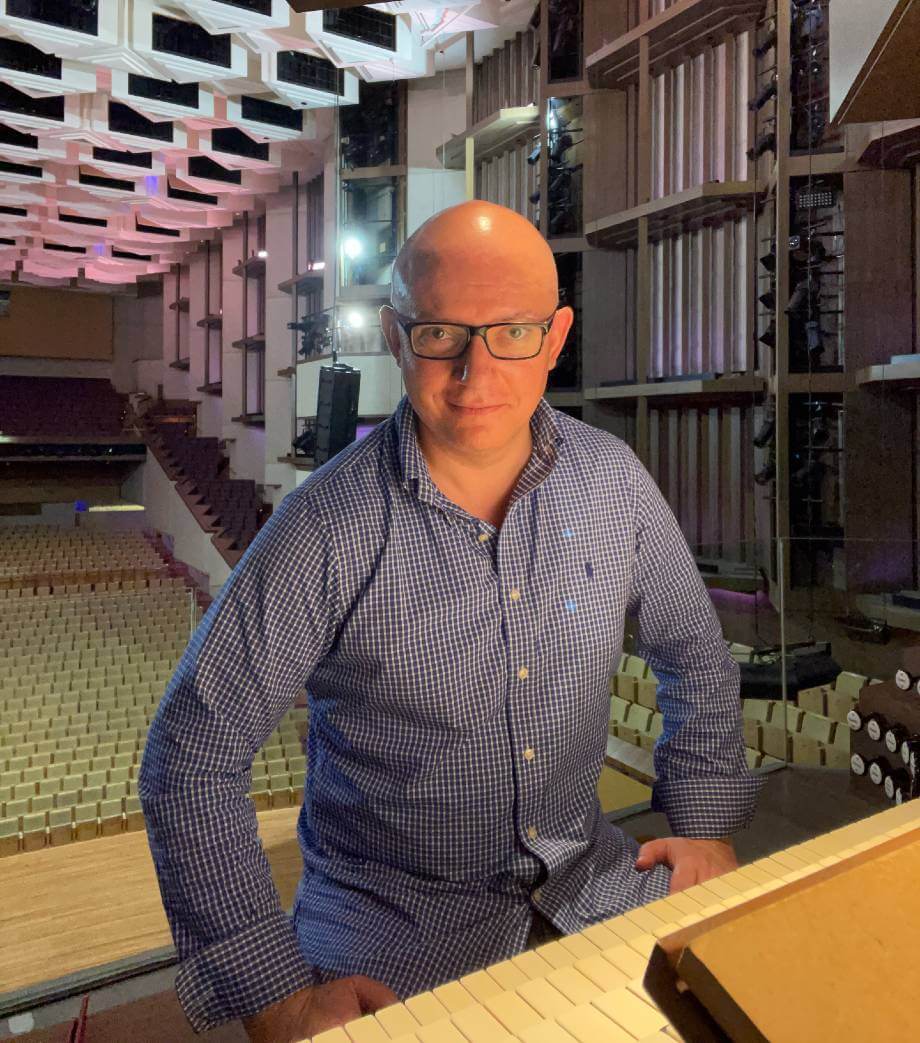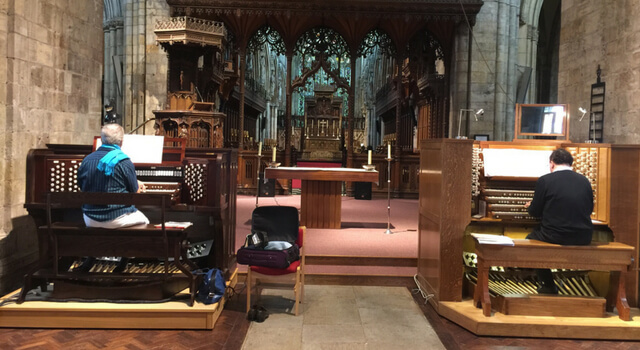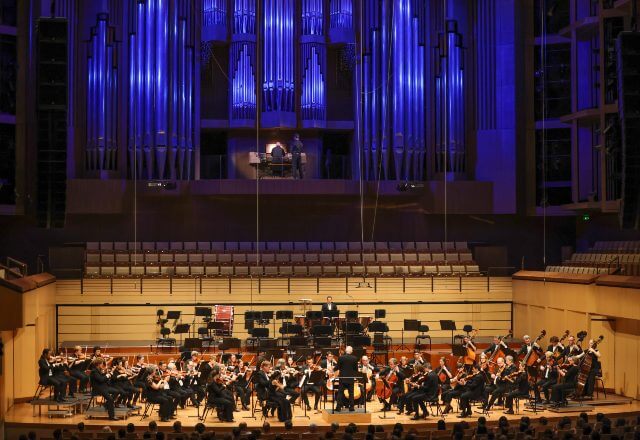The Queensland Symphony Orchestra on stage with Dr Joseph Nolan seated above at the Klais organ at QPAC Concert Hall – photo credit Peter Wallis
One of my favourite pieces for organ is the Concerto for Timpani and Strings written by Poulenc in 1936. The piece is not long, perhaps just 20 minutes, but unlike the more frequently performed Saint Saens Organ Symphony, the organ dominates this composition.
Poulenc cleverly draws on quotations from Bach’s G Minor Fantasia BWV 542 but sets them in a far less comfortable harmonic landscape. Do watch the video here where Dr Joseph Nolan gives a really interesting talk about the background to the composition illustrating the Bach quotations.
I have long wanted to hear Joseph play this concerto and but for the pandemic I rather think I would have made the trip to Brisbane for both performances. This piece is remarkable for its near instant transformation from frenetically energetic and aggressive mood to extremely quiet and melancholic moments, but its never long before the scampering pace returns.
It’s a piece ideally suited to Joseph’s extraordinary talents. I cannot commend the performance too highly and urge you to listen. As you would expect Joseph adeptly uses the full colour range of the wonderful Klais Organ at the QPAC Concert Hall to punctuate the performance of this masterpiece of 20th century composition.
Enigma Lunchtime Concert – Now available online
In this concert, Queensland Symphony Orchestra bring you three composers similar in their mastery, but very different in their sounds. It begins with Bach, where Dr Joseph Nolan performs Bach’s Fugue in C minor. Joseph then also plays Poulenc’s reflective Organ Concerto, before the QSO finishes with Elgar’s immortal Enigma Variations.
Listen to the Queensland Symphony Orchestra: Enigma Concert.
The first two pieces of music in this concert is JS Bach’s Prelude and Fugue in C minor, BvW 546. They both feature the majestic Klais Organ played by organist Joseph Nolan. Even though the Bach Prelude and Fugue was written for organ, the conductor Johannes Fritzsch has arranged the music for the Prelude for some of the brass instruments.
The second part of this concert features Francis Poulenc’s Concerto in G minor for Organ, Timpani and Strings. The composer Francis Poulenc had a lot of friends, one of which was Princess Edmond de Polignac who commissioned Poulenc to compose this organ concerto. The music is like a conversation between the different instruments. The organ is talking to the strings, while the timpani continuously chatters in the background.

Finally we have Edward Elgar’s famous Enigma Variations. In 1899, English composer Edward Elgar created his Enigma Variations, a set of variations on the one melody, with each one representing a different friend of his. From his wife to his music publisher, each friend was immortalised in music as their different personalities shone through. This piece has never lost popularity, especially with the moving and powerful ‘Nimrod’ variation.
Program
Johann Sebastian Bach (Arr Fritzsch): Prelude and Fugue in C minor, BWV 546
Francis Poulenc: Concerto For Organ, Timpani and Strings in G Minor
Edward Elgar: Variations on an Original Theme (Enigma), Op 36
Artists
Joseph Nolan (organ)
Queensland Symphony Orchestra
Johannes Fritzsch (conductor)
Listen to the Queensland Symphony Orchestra: Enigma Concert.
Recorded in the concert hall of QPAC, Brisbane on 10 April, 2021 by ABC Classic.
Battle of the Organs at Selby Abbey 2021
Once again later this year on September 3rd we are supporting Selby Abbey by putting on a ‘Battle of the Organs’ there with performers John Scott Whitely and Martin Baker.
They will be joined by Percussionist Barnaby Archer and perform the Poulenc Concerto, but with the 2nd organ taking the part of the strings. I wonder what that will sound like. I can hardly wait.

I have had a passion for church organs since the tender age of 12. I own and run Regent Classic Organs with a close attention to the detail that musicians appreciate; and a clear understanding of the benefits of digital technology and keeping to the traditional and emotional elements of organ playing.


